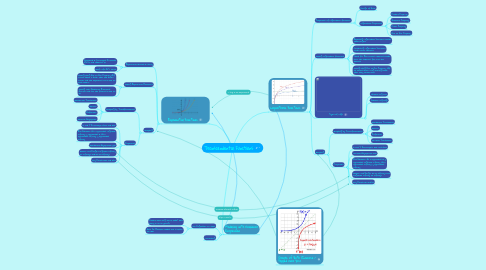
1. Exponential Functions
1.1. Exponential Growth & Decay
1.1.1. Compound & Continuous Interest (Pe^rt and N=(1+r/n)^t)
1.1.2. Half Life (Pe^(-.5)(t))
1.2. Solving Exponential Equations
1.2.1. Solving Using One to One Property (If terms share a base, then the bases cancel and the exponents are equal to each other)
1.2.2. Solving with Quadratic Equations (Factor and set the factors equal to 0)
1.3. Graphing
1.3.1. Graphing by Transformations
1.3.1.1. Horizontal Translation
1.3.1.2. Dilation
1.3.1.3. Reflection
1.3.1.4. Vertical Asymptote
1.3.2. Properties
1.3.2.1. X and Y Intercept: None and (0,1)
1.3.2.2. End Behavior: As x approaches negative infinity, y approaches 0. As x approaches infinity, y approaches infinity.
1.3.2.3. Horizontal Asymptote: y=0
1.3.2.4. Domain and Range: (negative infinity to infinity) and (0 to infinity)
1.3.2.5. Key Points: (0,1) and (1,b)
2. Modeling with Nonlinear Regression
2.1. Use Regression to Solve
2.1.1. Predict (How long will it take? How many in so-so years?)
2.1.2. Best Fit Equation (Which one is closer to 1.00)
2.2. Linearizing
3. Logarithmic Functions
3.1. Properties of Logarithmic functions
3.1.1. Change of Base
3.1.2. Logarithmic Properties
3.1.2.1. Product Property
3.1.2.2. Quotient Property
3.1.2.3. Power Property
3.1.2.4. One to One Property
3.2. Solving Logarithmic functions
3.2.1. Expanding Logarithmic Functions (make them longer)
3.2.2. Condensing Logarithmic Functions (make them shorter)
3.2.3. Check for Extraneous Solutions (make sure the solutions fall into the domain)
3.2.4. Solving Using One to One Property (If all terms share a log and log base, then they cancel out)
3.3. Types of Logs
3.3.1. Natural Log (Ln)
3.3.2. Common Log (log)
3.4. Graphing
3.4.1. Graphing by Transformations
3.4.1.1. Horizontal Translation
3.4.1.2. Dilation
3.4.1.3. Reflection
3.4.1.4. Vertical Translation
3.4.2. Properties
3.4.2.1. X and Y Intercepts: (1,0) and None
3.4.2.2. Vertical Asymptote: x=0
3.4.2.3. End Behavior: As x approaches 0, y approaches negative infinity. As x approaches infinity, y approaches infinity.
3.4.2.4. Domain and Range: (0 to infinity) and (negative infinity to infinity)
3.4.2.5. Key Points: 1,0 and b,1

